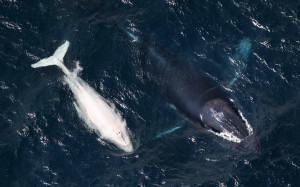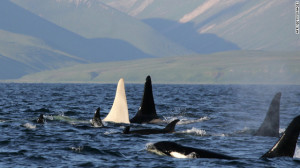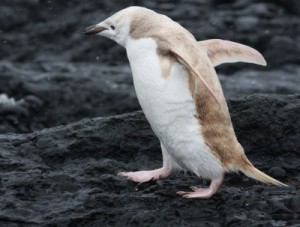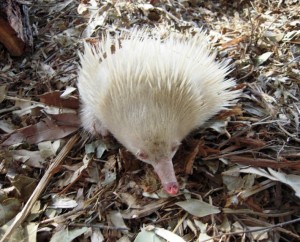Whales are all white!!
by Jillian Browning • June 24, 2014 • Announcements, Education • 0 Comments
White whales are dominating the news at the moment with Migaloo as the man of the hour. But why is he white?
Throughout history albino animals have been admired with many currently on display in zoos around the world.
In Australia we have our own white star, Migaloo an albino humpback whale. Migaloo was first spotted on the 28th of June 1991 off the coast of Byron Bay, Australia’s most easterly point. At that time Migaloo was the only documented white humpback whale in the world. Migaloo is believed to be aged between 25 -27. The name Migaloo comes from an Aboriginal word, translating to mean ‘white fella’ in the Mayi-Katuna language from north Queensland.
As a male humpback Migaloo is known for his wonderful singing ability, you can listen to his recordings here.
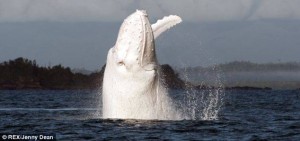
Scientists were not sure that Migaloo was a true albino, some photos indicated that he had brown eyes which would make him a hypo-pigmented humpback. Hypo-pigmented means a loss of skin colour or melanin. However, a study of Migaloo’s DNA conducted in 2011 from the Australian Marine Mammal Centre found that Migaloo is a true albino. The full paper can be downloaded here.
How rare are white whales?
White humpback whales are extremely rare but Migaloo is not the only one. There are 3 other white humpbacks known in the world.
A white whale called Willow lives up in the Arctic and was spotted along the coast of Norway in 2012. Another white whale named Bahloo was first seen off the Gold Coast in 2008. Bahloo and Willow have some black markings on their bodies indicating that they are not true albinos as Migaloo is.
And as an adorable addition an all white baby humpback whale was spotted off the East coast of Australia in 2011. It is believed that this calf is in fact the child of Migaloo but scientists need to conduct DNA tests to be sure. The calf has been affectionately named Migaloo Jnr.
The reason that Migaloo has all the fame is that he shows himself a lot more often than the others do and he is the only documented all white humpback whale.
Migaloo is very important for Humpback whale migration studies as he is an easily identifiable whale and sightings of him are recorded by scientists and whale watchers alike.
You can see all the Migaloo sightings at http://migaloo.com.au/
Humpbacks are not the only whales that have been found showcasing albinism. Albinism has been recorded in 20 Cetacean (whale and dolphin) species.
What is Albinism?
Albinism is when an animal is born without the pigments that give our skin, hair and eyes colour. 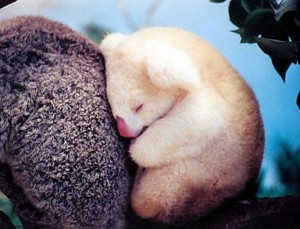 It can occur in any species, including humans. You may have seen albino animals; they appear white and will usually have red or pink eyes. Albinism is genetic, it is passed down from parents to their children.
It can occur in any species, including humans. You may have seen albino animals; they appear white and will usually have red or pink eyes. Albinism is genetic, it is passed down from parents to their children.
Albinos have a specific genetic trait that stops their cells producing a chemical called melanin.
Melanin is the pigment in skin, hair and eyes that gives animals their colour; it is also found in feathers and scales. Without any melanin animals have no natural colour and are considered albino.
Are all white animals albino
Not all animals that look white are true albinos. Some white animals are partial albinos; they might look white but have some coloured patches or coloured eyes. The easiest way to determine if an animal is a true albino is to check their eyes. The eyes of an albino will look red or pink because without colour in the eyes the red colour of the animal’s blood vessels shows through.
An animal with partial albinism is referred to as leucistic. Like this blonde chinstrap penguin.
White danger!
Albino animals may be appreciated by humans as rare and fascinating creatures but in the wild they are an easy target for predators. Many animals use their colour as a camouflage to hide and escape from predators. Unfortunately for albino animals, unless you live in the snow hiding can be difficult, and they are in greater danger of being someone’s meal.
This is not the only hardship that albino animals face in the wild. Melanin provides a natural defence against harmful sunlight such as UV rays. Albino animals have no melanin and have a greater risk of developing skin cancer or suffering damage to their eyes.
All animals can be white
Animals from all walks of life can be albino, including mammals, birds, reptiles and fish.
At Potoroo Palace in Merimbula they have an adorable albino echidna named Luna on display.
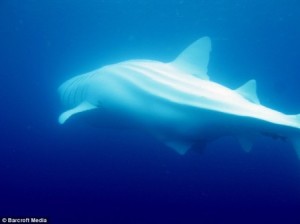
An albino whale shark

